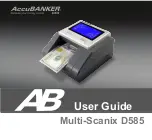
181
The schematic diagram at right shows the details of the 100 KHz SCP count
input circuit, the terminals used for sensor connection and the configuration set-
up switches. These switches are the first three switches in the switch bank and
are designated S1, S2 and S3 from left to right. The functions of these switches
are as follows:
S1 - ON (SRC):
Provides 3.9 K
W
Pull-down load for sensors with sourcing
outputs.
(Max. sensor current, 3 mA)
OFF (SNK):
Provides a 7.8 K
W
Pull-up load for sensors with sinking
outputs.
(Max. sensor current, 1.6 mA)
S2 - ON (LO FRQ):
Connects damping cap for switch contact debounce.
Limits count speed to 100 cps maximum. Min. count pulse
ON/OFF times-5 msec.
(See Note 2)
OFF (HI FRQ):
Removes damping cap, allows operation to 100 KHz.
Min count pulse ON/OFF times-5 µsec.
S3 - ON (LO BIAS):
Sets input trigger levels to the low range to accept logic
pulses with 0 to +5 V swings.
(V
IL
= 1.5 V, V
IH
= 3.75 V, See
Note 3)
OFF (HI BIAS):
Sets input trigger levels at mid-range to accept outputs
from 2-wire proximity sensors, resistive photo-cells and
logic pulses with full 0 to +12 V swings.
(VIL = 5.5 V, V
IH
= 7.5 V, See Note 3)
SENSOR INPUT CONNECTIONS & INPUT CONFIGURATION SWITCH SET-UP
1.
SENSOR SUPPLY VOLTAGE AND CURRENT
Sensor supply voltage on Term. “A” is +12 VDC nominal with ±15%
variation due to line and internal load variation.
All RLC sensors will
accommodate this variation)
. Maximum sensor current rating varies
depending on the specific counter model
See Specifications of specific
model)
. This rating is the maximum allowable sensor current when all digits
of a 6-digit unit display 8’s, and with 100 mA relay load
(s)
on preset
counters. If all 6 digits are not used, an additional 45 mA is available for each
digit not displayed. 4-digit models will deliver an additional 90 mA over the
current rating stated. SC counter power supplies are not regulated, and in
multiple counter
(or counter/tachometer)
installations all terminal “A’s” and
“B’s” can be paralleled for load sharing. For unusually high sensor current
requirements, use Accessory Power Supply
(See Accessory Section of
Catalog)
.
2.
HI/LO FRQ. SELECTION
The HI/LO FRQ Selection switch MUST be set on LO FRQ when switch
contacts are used to generate count input signals. Since the LO FRQ mode
also provides very high immunity against electrical noise pickup, it is
recommended that this mode also be used whenever possible with electronic
sensor outputs, as added insurance. The LO FRQ mode can be used with any
type of sensor output provided count pulses never decrease below 5 msec,
and the count rate does not exceed 100 cps.
3.
V
IL
and V
IH
levels given are nominal values ±10% when counter voltage on
terminal A is +12 VDC. These nominal values will vary in proportion to the
variations in Terminal A voltage caused by line voltage and load changes.
4.
When shielded cable is used, shield should be connected to terminal B at
counter and left unconnected at sensor end.
5.
The Count Input
(Terminal C)
, can accept source pulses from other circuits
up to +28 V in amplitude. For voltages above +28 V a limiting resistor and
zener diode should be used to limit the voltage at Terminal C. Negative input
voltages to Count Input
(Terminal C)
, will damage the input circuit. If the
possibility exists that the input voltage can swing negative, an external shunt
or series diode should be used to block the negative swing.
NOTES:
COUNT SWITCH OR ISOLATED TRANSISTOR OUTPUTS
SENSORS WITH CURRENT SINK
SENSORS WITH CURRENT SOURCE
CURRENT SOURCE CONNECTED
CURRENT SINK CONNECTED
OUTPUT (NPN O.C.)
OUTPUT (PNP O.C.)
(INCREMENT ON CLOSING)
(INCREMENT ON OPENING)
(INCREMENTS ON TURN-OFF)
(INCREMENTS ON TURN-ON)
RLC SENSOR MODELS: MPS, RR & PR PHOTO ELECTRICS
TWO WIRE PROXIMITY SENSORS
OLDER STYLE SENSORS WITH
A.C. INPUTS FROM MAG PICKUPS,
INTERFACING WITH CMOS
INTERFACING WITH TTL
CURRENT SOURCE CONNECTED
-EF OUTPUT, CURRENT SOURCE
TACH. GENERATORS, INVERTERS,
CIRCUITRY (B TYPE)
(INCREMENT ON CURRENT RISE)
CONNECTED
(INCREMENT ON + EDGE)
ETC.
Summary of Contents for CUB 1
Page 30: ...7 This page intentionally left blank...
Page 46: ...5...
Page 47: ...6...
Page 48: ...7...












































